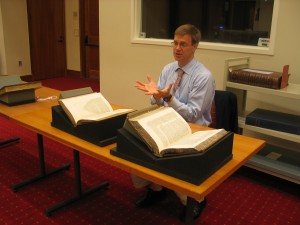 Shown here is a snapshot of my little area and a few things we discussed today–of particular interest is the plastic “tackle box” full of samples of type, leading, linotype, wood type, ornaments, a monotype sheet, and other THINGS related to printing history. To construct a kit like this for students is fairly easy, and I plan to put at least two kits together for the Watkinson this fall.
Shown here is a snapshot of my little area and a few things we discussed today–of particular interest is the plastic “tackle box” full of samples of type, leading, linotype, wood type, ornaments, a monotype sheet, and other THINGS related to printing history. To construct a kit like this for students is fairly easy, and I plan to put at least two kits together for the Watkinson this fall.
We have spent a fair amount of time throughout our discussions moving back and forth, as it were, between what constitutes (or should) our most global pedagogical goals in terms of book history, and the ways in which we can effect those goals “on the ground.” How we teach, and what we teach, and our imagined outcomes, will of course depend on many factors.
It is the (good) goal of the course to provide, say, a member of the faculty teaching early modern European intellectual history on the one hand, and a library staffer who must present a one-off session to an English literature class on the other, a set of approaches and resources to employ with sufficient flexibility to meet most goals, and to, as effectively as possible given those goals, answer the questions, “what do we see?” [and therefore] “what do we know?” [and therefore] “now that we know this, what can we say?”
The week has been fairly intense, but RBS is always fun BECAUSE of this intensity. If you bring 100+ book folk, who are all highly intelligent and very quirky in their own ways, together in an enclosed space for any amount of time, lots of great things happen. As it is the last week of this RBS session, the staff is getting a little wild around the eyes–hence the need for comic relief, provided here my Michael as he attempts to “wrangle” a library “snake.”
Much of today was a rapid-fire list of books, articles, etc. to use for various purposes that were not in our online “workbook,” and a discussion of the merits of each of them took some time. Then we were in special collections to look and talk about more potential pairings of material, which can happen virtually as well as physically (for those without the luxury of large collections). I am happy to say that the Watkinson lacks nothing in terms of its ability to support any sort of book history teaching that Trinity will ever likely need or want to do–at least in terms of the West, from the 12th century to the present!
I am happy to say that the Watkinson lacks nothing in terms of its ability to support any sort of book history teaching that Trinity will ever likely need or want to do–at least in terms of the West, from the 12th century to the present!

